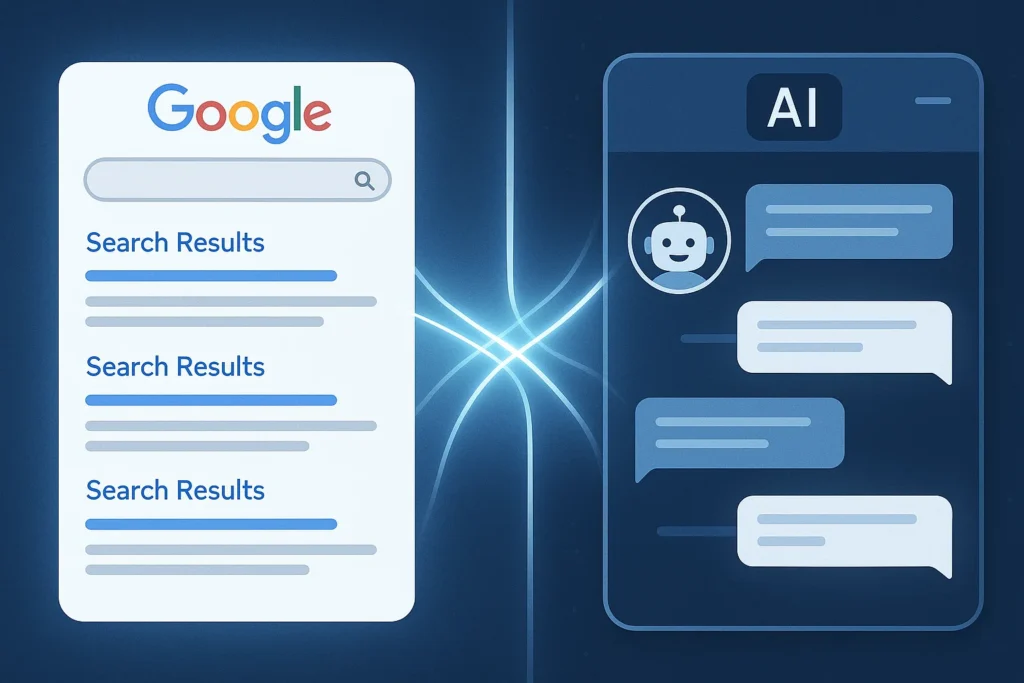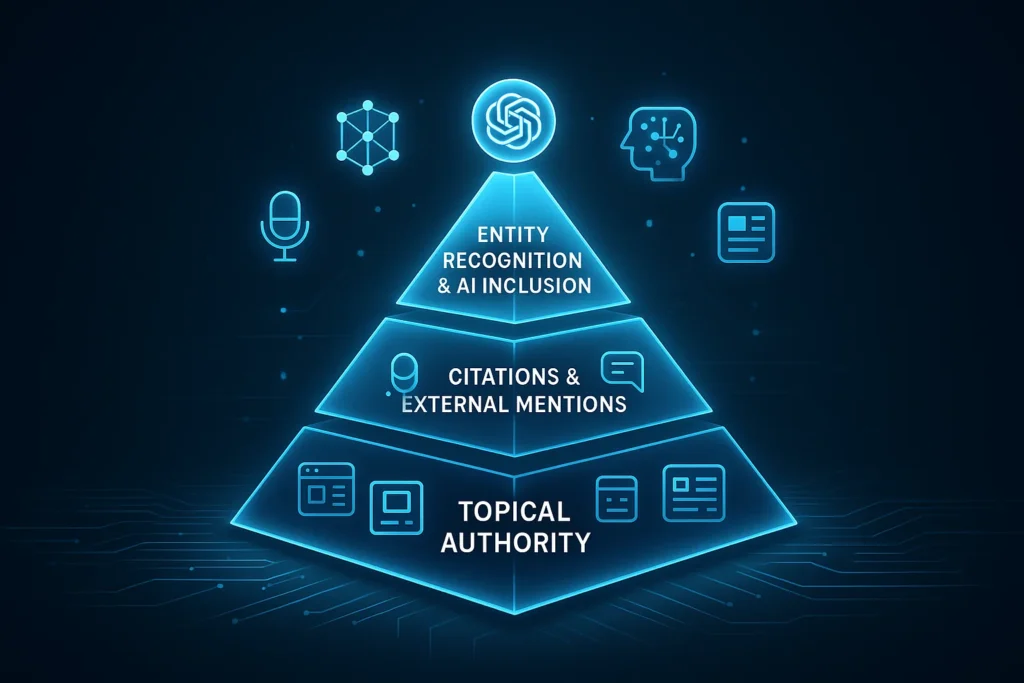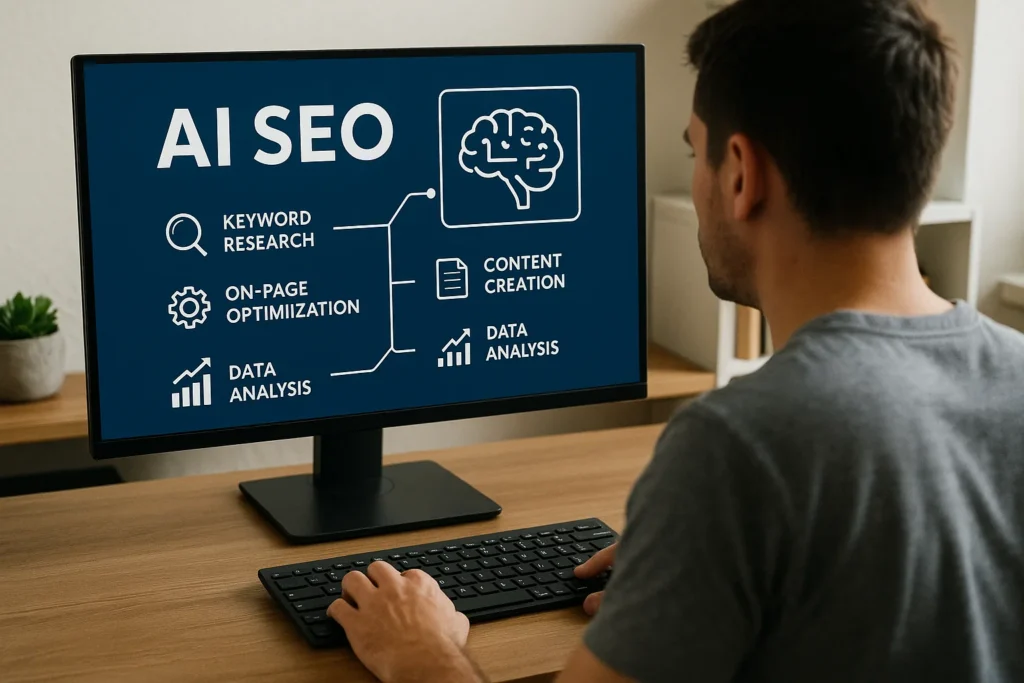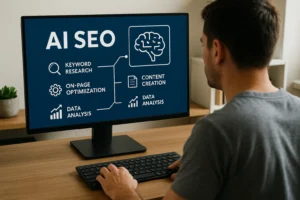Ever feel like your SEO playbook gets rewritten every six months? Same here… And honestly, lately, it feels more like every six weeks.
The truth is, the rules of search visibility aren’t just shifting — they’re being completely reinvented by AI. I’m not just talking about the classic Google algorithm updates we’ve all come to expect. I’m talking about a new layer of discovery altogether: AI assistants like ChatGPT, tools like Perplexity, and those generative answers popping up in your searches.
For growth-driven businesses — especially in B2B, SaaS, and tech — this isn’t just an interesting trend to watch from the sidelines. It’s a real-time evolution that directly impacts how your buyers find, research, and trust your brand.
If your company depends on pipeline growth, high-intent traffic, or building authority in competitive markets, AI SEO needs to be on your radar. It’s not just about ranking in Google anymore — it’s about showing up in AI conversations, answers, and recommendations.
In this article, I’ll break down what AI SEO actually means, why it matters more than ever, and how B2B and SaaS marketers can adapt before their competitors do. Let’s dive in.
What is AI SEO? (And Why It’s Not Just Another Buzzword)
Let’s get this out of the way — AI SEO isn’t just another shiny marketing term that’ll fade out in six months. It’s already reshaping how search works, whether we like it or not.
At its core, AI SEO is the combination of artificial intelligence and good old-fashioned search engine optimization, designed to improve your visibility not just in Google’s traditional blue links — but across AI-powered platforms, assistants, and conversational interfaces.

Think about where people are searching today. Sure, they still use Google, but they’re also asking ChatGPT for recommendations. They’re using Perplexity to shortcut research. They’re seeing answers pop up directly in AI-generated snapshots — before they even click on a website.
The evolving search landscape looks something like this:
- Google’s Search Generative Experience (SGE): AI-crafted summaries, product recommendations, and research insights right at the top of results.
- ChatGPT, Claude, Gemini, Perplexity: Conversational AI tools offering direct answers and content suggestions.
- Emerging AI-driven platforms: Even more tools in the pipeline, all shaping how buyers discover brands.
Here’s where the big distinction comes in:
- Traditional SEO focuses on keywords, backlinks, technical optimization — all aimed at ranking your site in organic search results.
- AI SEO optimization adds a new layer. It’s about making sure your brand, content, and expertise show up inside AI-generated answers, conversation threads, and knowledge graphs.
In other words, your website might rank — but if AI tools aren’t pulling from your content when they “speak,” you’re missing the conversation entirely.
And for B2B, SaaS, and tech brands competing for trust and visibility, that’s a gap you can’t afford.
The rise of AI-driven search experiences
If it feels like search is turning into something entirely different — that’s because it is.
The way people look for information is evolving fast. Instead of typing keywords into Google and scrolling through pages of links, more folks are turning to AI assistants to get direct, conversational answers. And here’s the game-changer: those AI tools aren’t always pulling results straight from search engines — they’re pulling from curated datasets, trusted sources, and whatever brand has managed to get into their knowledge base.
Let’s break that down with a few real-world examples:
- ChatGPT and Claude: People now ask these AI tools everything from “What’s the best CRM for startups?” to “Give me a list of cybersecurity companies in Europe.” If your brand’s not part of the sources these models rely on, you’re invisible — even if your website ranks on Google.
- Perplexity’s Geo-Answers: Perplexity doesn’t just provide general responses — it offers location-specific, citation-backed recommendations. If your business operates in SaaS, B2B tech, or product-led spaces, getting visibility here could mean becoming part of the short list your ideal buyer sees first.
- Google’s Search Generative Experience (SGE): This is where AI-generated summaries, product options, and recommendations appear before organic results — shifting how people make decisions long before they scroll down.
In short, AI-driven search is more conversational, more personalized, and more filtered. It’s not about ten blue links — it’s about becoming part of the answer itself.
And for growth-focused brands, especially those in SaaS and B2B, showing up at this AI-powered layer can directly influence awareness, trust, and pipeline generation.
But here’s the kicker — optimizing for this space requires a mindset shift, which brings us to the next section…
Why growth leaders should care about AI SEO optimization
If you’re leading growth, demand generation, or marketing at a B2B, SaaS, or tech company, here’s the reality — AI SEO isn’t just a “nice to have” anymore. It’s quickly becoming a competitive advantage… or disadvantage, depending on how you play it.
Let me put it plainly:
Your buyers are still searching — but they’re not always using search engines the way they used to. They’re relying on AI tools for answers, recommendations, and research shortcuts. If your brand doesn’t show up in those answers, your competitors will.
Here’s why this matters for growth-focused teams:
- Miss the AI layer, miss qualified demand: AI-driven tools are filtering the noise and serving up condensed, high-trust answers. If your expertise isn’t part of that filtered content, potential buyers may never reach your site.
- Influence trust early in the funnel: When your brand shows up in an AI assistant’s recommendation or an SGE-generated summary, you earn visibility before the traditional SEO battle even starts. That shapes perception and trust long before sales touches them.
- Protect your competitive edge: Let’s be honest, most growth teams are still playing catch-up on AI SEO optimization. The ones that figure it out first? They’ll own a disproportionate share of AI-powered visibility for months — maybe years — before the rest catch on.
And here’s the part most leaders overlook: AI SEO isn’t a replacement for your existing strategy — it’s an extension. It amplifies your thought leadership, your content, and your brand authority across new platforms where buyers are increasingly looking for guidance.
Bottom line? If growth is your mandate, AI SEO optimization needs to be part of the playbook. Because visibility at this AI-driven layer won’t just drive traffic — it’ll drive trust, conversations, and pipeline.
Core pillars of a modern AI SEO strategy
Alright, so if AI SEO isn’t just hype — how do you actually approach it?
The good news? You don’t need to reinvent your entire marketing stack. But you do need to evolve your strategy to meet how AI systems — and your buyers — consume information today.
Here’s where to start:
1. Semantic SEO and entity optimization
Traditional SEO used to be all about keywords. But AI models don’t think in keywords — they understand topics, entities, and relationships.
That means your content needs to signal relevance beyond simple phrases. You want to build clear associations around your brand, expertise, and core topics, so AI knows how to connect the dots.
For example, if you’re a SaaS company specializing in cybersecurity for financial services, your site, content, and third-party mentions should consistently reflect that niche — across language, structured data, and external citations.
2. Structured data and content markup
AI crawlers and search engines rely on structured data to understand your site at a deeper level. Schema markup, entity tagging, and knowledge graph connections help AI systems categorize your expertise — making your brand more “findable” inside generative answers and chatbots.
If your site’s missing this layer, you’re basically whispering to AI in a crowded room — and expecting to get noticed.
3. Content designed for AI visibility
Think answer-focused, concise, and expertise-led content. Generative AI tools pull from clear, authoritative sources that align with user intent.
That means:
- Well-structured, skimmable content.
- Direct answers to high-intent questions.
- Building topical depth — not just chasing keywords.
It’s less about clickbait, more about becoming the reliable source AI models want to reference.
4. Building authority signals across the web
It’s not just about your website. AI tools pull from multiple sources to understand credibility — including third-party mentions, reviews, citations, and trusted databases.
Your brand needs a footprint beyond your homepage. Think podcasts, guest features, thought leadership, industry directories — all feeding into how AI perceives your authority.
Bottom line: AI SEO optimization isn’t one magic trick — it’s a system of interconnected signals designed to help your brand surface across both traditional search and AI-driven platforms.
Master these pillars, and you’ll be steps ahead of competitors still stuck optimizing only for Google’s old playbook.
AI SEO tools: Your tech stack for AI-driven visibility
Look, I’ll be honest — no AI SEO strategy works without the right tools in your corner. This space is evolving fast, and trying to track AI-driven visibility manually? You’d need 48-hour days.
Thankfully, there’s a growing stack of AI SEO tools designed to help you stay visible across both traditional search engines and AI-powered platforms. Let’s walk through the essentials:
1. Content optimization tools powered by AI
These help you align your content with how AI models interpret topics, relevance, and authority. Popular options include:
- Surfer SEO — Great for optimizing on-page content with real-time suggestions based on top-performing pages and semantic keywords.
- Clearscope — Ideal for refining content depth and relevance, especially for SaaS, tech, and B2B articles.
- Frase.io — Combines content briefs, SEO optimization, and AI-driven writing suggestions to make your content more AI-friendly.
2. AI visibility monitoring tools
This is where things get interesting. New tools are emerging to track how — and if — your brand is showing up in AI-generated answers from platforms like ChatGPT, Perplexity, and others.
While the space is early, Reddit communities like r/SEO and r/DigitalMarketing have been buzzing with early adopters sharing tactics and tool recommendations. Expect more dedicated visibility trackers to hit the market soon.
3. Knowledge graph and entity management platforms
AI systems love structured, connected information. Tools like:
- Schema.org markup generators
- WordLift for automating structured data
- Kalicube for managing your brand’s entity presence
…help ensure your business becomes part of the knowledge ecosystem AI tools pull from.
4. AI SEO content monitoring add-ons
Some traditional SEO platforms like Ahrefs and SEMrush are rolling out AI-focused visibility reports — tracking shifts in AI-generated search experiences or SGE placements.
A quick reality check: AI SEO tools won’t do the thinking for you. They help amplify your efforts, identify gaps, and stay visible — but human strategy still matters. Especially for nuanced, high-trust industries like SaaS, B2B tech, or product-led growth markets.
The smartest growth teams are blending AI SEO tools with real expertise to stay ahead of both traditional search and AI-driven discovery.
How to gain visibility inside AI-powered tools like ChatGPT
Here’s where the conversation gets really tactical — because ranking on Google is one thing, but showing up in AI-generated answers from tools like ChatGPT? That’s a different challenge altogether.
And honestly, a lot of marketers are still guessing their way through this. But the good news is, there’s already a growing body of best practices coming from SEO experts, early adopters, and real-world experiments. Let’s break it down.
How does ChatGPT (and tools like it) choose what to “say”?
These models don’t surf the web live the way Google’s crawler does. Instead, they’re trained on massive datasets — which include websites, articles, research papers, trusted databases, and more. If your brand, your expertise, and your content aren’t part of those trusted sources, you’re unlikely to be recommended when someone asks for solutions, tools, or advice in your space.
So how do you improve your AI visibility? Here’s the short list:
1. Optimize for conversational queries
People interact with AI tools differently than search engines — it’s more natural, more question-based, and often more specific.
Instead of just targeting keywords like “best CRM software,” think:
- “What’s the best CRM for startups under 50 employees?”
- “Can you recommend project management tools for SaaS companies?”
By creating content that directly answers these nuanced, conversational questions, you increase your odds of being pulled into AI responses.
2. Strengthen your brand entity recognition
Reddit threads like this one emphasize the importance of building your brand as a recognizable entity across trusted sources. That means:
- Consistent citations in reputable articles and directories
- Schema markup clearly defining your brand details
- External content (guest posts, podcasts) reinforcing your niche authority
The more signals you send about who you are and what you’re known for, the more likely AI models are to include you in relevant answers.
3. Influence AI knowledge graphs and training sources
This one takes time, but it pays dividends. Many AI systems pull from structured knowledge graphs (think: Wikipedia, Crunchbase, major databases) when forming answers.
If your company’s missing from those datasets — or inaccurately represented — your AI visibility suffers.
Pro tip: Start by ensuring your presence is updated and optimized in publicly accessible knowledge sources relevant to your industry.
4. Don’t ignore Perplexity and similar platforms
Tools like Perplexity’s Geo-Answers are evolving fast blending AI-generated responses with location-specific, citation-backed recommendations. For B2B and SaaS companies targeting specific markets, that’s a goldmine of targeted visibility… if you show up.
Final takeaway? Gaining visibility in AI tools like ChatGPT isn’t about gaming the system — it’s about building real authority, aligning with how AI processes information, and being intentional with your content strategy.
Common pitfalls to avoid with AI SEO optimization
Alright, let’s get real for a second. As exciting as AI SEO sounds, it’s also easy to get tripped up — and I’ve seen plenty of smart teams fall into these traps. The space is still new, the rules are evolving, and honestly, there’s a lot of noise out there.
So, if you’re serious about building visibility across AI-driven platforms, here are a few missteps to avoid:
1. Over-focusing on traditional keywords
Look, keywords still matter — but AI models don’t just look for specific phrases. They understand context, relationships, and entities.
If your content is stuffed with keywords but lacks real topical depth or authority signals, AI tools are less likely to pull from it. Think bigger than keywords — think expertise ecosystems.
2. Ignoring how AI prioritizes information
Here’s the thing: AI models don’t just scrape any content — they rely on high-trust, structured, and often cited information sources.
If your site lacks clear structure (like schema markup), trusted third-party mentions, or recognizable brand signals, you’ll struggle to surface in AI-generated answers, no matter how optimized your blog posts seem.
3. Treating AI visibility as a one-off project
I’ve seen this a lot already — companies running a quick AI SEO sprint, expecting instant results, then moving on.
But visibility inside AI systems is an ongoing effort. Models get updated, new platforms emerge, and your competitors keep evolving. Building AI visibility is more like maintaining your LinkedIn presence — consistent updates, thought leadership, and staying relevant.
4. Underestimating the influence of off-site authority
Your website is just one part of the puzzle. AI models pull signals from across the web — podcasts, directories, expert roundups, trusted databases.
If your brand isn’t part of that broader ecosystem, your chances of being referenced by AI tools shrink fast. Building authority beyond your domain is key.
5. Chasing AI “hacks” over long-term strategy
There’s already plenty of chatter about gaming AI visibility with shortcuts — but just like old-school SEO hacks, they won’t last.
The brands that win long-term are the ones investing in real authority, expertise-driven content, and building credible digital footprints.
Bottom line? AI SEO optimization isn’t about tricks — it’s about positioning your brand as a reliable, high-value resource in the places AI tools pull from. Avoid these pitfalls, and you’ll be miles ahead of the curve.
The AI visibility pyramid: A practical framework
Let’s be honest, AI SEO can feel overwhelming — new platforms, new algorithms, new rules. But thankfully, there’s a simple way to structure your approach so you’re not chasing your tail.
That’s where the AI visibility pyramid comes in. Shoutout to the folks over at Animalz for framing this so clearly. It’s basically a step-by-step model for earning your spot inside AI-driven answers, conversations, and recommendations.
Picture a pyramid with three layers — each one building on the other:

1. Topical authority (the foundation)
This is your home base. Before AI tools reference your brand, they need to see you as a trusted expert on your specific topics.
For example, if you’re a SaaS brand specializing in customer success software, your site, blog, and digital footprint should consistently reinforce that expertise. AI models love patterns — the clearer your topical signals, the stronger your foundation.
How to build it:
- Consistently publish high-quality, in-depth content in your niche
- Use structured data (schema) to clarify your topics to AI crawlers
- Align your site architecture around core themes, not random blog posts
2. Citations and external mentions (the middle layer)
AI tools are skeptical by default — they trust information that’s verified across multiple sources. That means your brand needs credible mentions beyond your own website.
This layer builds your authority through:
- Industry blogs, news outlets, and podcasts mentioning your expertise
- Inclusion in trusted directories or data aggregators (think Crunchbase, G2, etc.)
- Positive third-party content that reinforces your niche positioning
The more consistent, high-authority citations you earn, the more AI models associate your brand with reliable information.
3. Entity recognition and AI system inclusion (the peak)
This is the gold standard — becoming part of the knowledge bases, training datasets, and structured entities that AI tools actively reference.
It’s harder to control directly, but your efforts from layers one and two feed into this. Over time, AI models like ChatGPT, Perplexity, and Google’s SGE start recognizing your brand as a reliable source — pulling your expertise into answers, recommendations, and summaries.
Quick analogy:
Building AI visibility is like climbing a mountain. You can’t skip to the top without putting in the groundwork. But with consistent, structured effort, you gradually elevate your brand into those AI-powered conversations where real buying decisions start.
For growth-focused leaders, mastering this pyramid isn’t just SEO 2.0 — it’s securing your spot in the next generation of discovery.
The future of AI SEO: Where this is heading
If there’s one thing I’ve learned after years in growth marketing, it’s this — by the time most companies react to a shift, the early adopters are already winning.
And when it comes to AI SEO? We’re still early… but the pace is accelerating fast.
So where’s all this heading? Let’s look around the corner:
1. AI will become the first point of discovery for many buyers
We’re already seeing it — people asking ChatGPT for product recommendations, troubleshooting advice, or solution comparisons before they Google anything.
For B2B, SaaS, and product-led businesses, this means your future buyers could make shortlist decisions inside an AI chat — without ever landing on your website. Being part of those AI-driven conversations isn’t optional.
2. Search engines are blending traditional SEO with AI-generated content
Google’s Search Generative Experience (SGE) is just the beginning. Expect more AI-crafted summaries, product comparisons, and research snapshots baked directly into search results.
If your content isn’t optimized for both human readers and AI systems, your visibility risks getting buried under AI-curated layers.
3. Knowledge graphs and structured data will shape AI inclusion
As AI models rely more on structured data, trusted sources, and entity recognition, your technical SEO foundation becomes mission-critical. It’s not just about backlinks — it’s about making your brand machine-readable across platforms.
4. AI visibility will separate market leaders from everyone else
Here’s the hard truth: brands that master AI SEO early will dominate visibility, authority, and buyer mindshare. Those who delay? They’ll be playing catch-up — potentially for years.
And it’s not just about traffic numbers anymore — it’s about shaping AI’s perception of your brand. That perception directly influences how you show up (or don’t) in AI-generated answers, recommendations, and buyer research journeys.
Final thoughts — Turning AI SEO into your growth advantage
Look, I get it — AI SEO can feel like just one more thing on an already packed marketing to-do list. But here’s the honest truth: the brands that lean into this now will shape how their market sees them for years to come.
It’s not about chasing every shiny AI tool or completely overhauling your strategy overnight. It’s about being intentional, building authority, and positioning your brand where the future of discovery is already happening.
So where do you start? Small steps that compound:
- Audit your existing content — are you answering real, conversational questions your buyers ask AI tools?
- Strengthen your brand signals — structured data, consistent topical authority, third-party mentions.
- Watch how platforms like ChatGPT, Perplexity, and Google’s SGE evolve — and adapt along the way.
And if you’re in B2B, SaaS, or leading growth for a product-driven business? AI SEO isn’t a side project — it’s quickly becoming part of how you control your pipeline, authority, and competitive edge.
The brands that adapt early? They’ll own more than rankings — they’ll own buyer trust inside AI-powered conversations.
If you’re ready to turn AI SEO into a strategic advantage for your business, I’d love to help. You can always reach out here — let’s chat about where your growth strategy stands and how we can align it with this new AI-driven landscape.
Because the playbook’s changing — and the sooner we adapt, the stronger your brand shows up, everywhere your buyers are looking.





